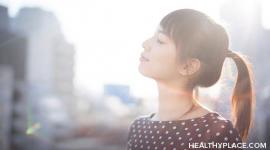Relaxation Techniques for Anxiety: How to Relax Your Mind

Engaging in relaxation techniques for anxiety really does help relax your mind and body. Such techniques are purposeful exercises done intentionally and regularly to effectively reduce anxiety. If you’ve ever been told by a well-meaning but misguided person to “just relax, and everything will be fine,” you may be skeptical of any claim that relaxing helps anxiety or that relaxation is even possible when you have anxiety.
Relaxation techniques go far beyond the words “just relax.” Numerous studies (Bourne, 2010) have demonstrated that regularly practicing relaxation helps the brain and body. Not only do heart and respiration rate decrease, so do blood pressure, muscle tension, and metabolism. Further, anxiety, stress, and even the intensity and frequency of panic attacks decrease. Relaxation increases alpha waves, the brain waves associated with a relaxed mind relatively free of unwanted thoughts. Teaching yourself to relax when you have anxiety will help you decrease anxiety in both the short- and long term.
Tips for Using Relaxation Techniques for Anxiety
To help you get the most out of relaxation exercises, keep a few important things in mind.
- Be patient with yourself. Sadly, relaxation isn’t a natural human state of existence. People intentionally learn how to relax with anxiety, and you can, too.
- Start slowly. Begin with short relaxation sessions, even just a few minutes at first and gradually increase as you go.
- Don’t force it. It’s not uncommon for people to impose rules and expectations onto themselves, believing they “should” be able to relax. This actually prevents relaxation.
- Similarly, let go of the need to control how a particular technique works or how a given session goes. Just let it be. That alone helps relaxation.
- Relaxation is learned, which means it takes practice. To fully benefit, practice some form of relaxation daily, even if it’s not very long. The ideal relaxation period is 20-30 minutes (Bourne, 2010), but that isn’t rigid.
Following these guidelines will improve your relaxation practices, which in turn decrease anxiety.
How to Relax Your Body and Mind from Anxiety: Relaxation Techniques
- Engage in simple deep breathing, inhaling slowly through the nose and exhaling slowly through the mouth.
- Breathe into your tension. Notice areas of tension and tightness in your body. As you inhale deeply, imagine your breath flowing into these areas. Exhale slowly, relaxing and releasing the tension. You can repeat a word or a phrase as you exhale, such as “relax.”
- Visualize a calm setting to induce relaxation and reduce anxiety. Choose a scene that is inviting and calming. You can imagine a place in your mind or look at a picture. Nature settings are commonly used because they induce relaxation, but anything that brings you peace works. Breathe deeply while you imagine or study the image. Let yourself get lost in it. When your mind wanders, just gently return your attention to the peaceful setting.
- Use guided imagery. Here, you visualize a calm setting, but someone, either a live person or a voice on a guided relaxation track, guide you through a visualization exercise.
- Progressive muscle relaxation involves tensing and releasing muscle groups in the body. Start with your feet, and work your way up to your head. You can do this on your own or with a guided track.
- Passive muscle relaxation is similar to progressive muscle relaxation but without the tightening component. With passive muscle relaxation, you scan your body from feet to head and just visualize each muscle group relaxing.
- Listen to calming music. Listening to gentle music or nature sounds that calm you has tangible relaxation and anxiety-reducing effects.
- Meditate. Meditation is a powerful anxiety-reducer. Practice meditation, and you’ll learn how to relax with anxiety. In a very basic form, mediation involves sitting comfortably and quietly, closing your eyes, and breathing slowly and deeply. Anxious thoughts might race, but that’s okay. Just notice them, let them drift away, and return your mind to your breathing. Having thoughts isn’t a problem. Getting caught up in them, struggling with them, is what prevents relaxation.
- Use biofeedback. Unlike the other relaxation techniques, biofeedback must be practiced with a trained professional. However, if you can find a practitioner, biofeedback is a proven way to induce relaxation because it increases the brain’s alpha waves. In biofeedback, you’re attached to a machine that painlessly reads your brain activity and provides feedback regarding when your alpha waves increase and decrease. You can look for patterns and do more of what increases your alpha waves.
With these relaxation techniques for anxiety, you’ve seen how to relax your mind and body in order to reduce anxiety. Relaxation helps you feel less anxious in the moment, and it helps you have a more relaxed, less anxious, state of existence overall.
APA Reference
Peterson, T.
(2021, December 21). Relaxation Techniques for Anxiety: How to Relax Your Mind, HealthyPlace. Retrieved
on 2026, January 16 from https://www.healthyplace.com/self-help/anxiety/relaxation-techniques-for-anxiety-how-to-relax-your-mind



